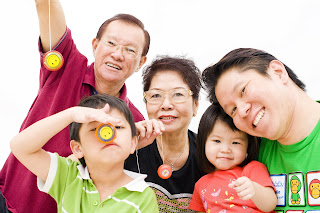I am delighted to be invited to speak during the Kindergarten Learning Forum (KLF) later this month. This is sure a stretch of my flexibility to cater to the specific needs of a special group of educators. This is even more meaningful as my own kids are in the pre-school going age, especially for Joshua where I have witnessed his cognitive development under the guidance of very creative teachers from 3 different pre-schools.
As I pondered on how best to demonstrate some of the key creative metaphors behind Torrance's pioneering work on creativity in education, I decided to design a playful approach to demonstrate learning about Creatively in an experiential manner. I am keen to observe how the Torrance Incubation Model can be the “... a simple, powerful, general-purpose teaching model that integrates creativity skills with content and knowledge” (Torrance, 1993, p. 187). In my 45 minutes workshop, I hope to explore and witness the integrative potential of this model that combines both the anticipatory and participatory teaching and learning approach.

Stage 1: Heightening Anticipation
Of late, the craze and revival of playing yo-yo struck an interesting cord with me and my kids. As a father, I enjoy the discussion and testing of ideas together with Joshua on the different yo-yo strategies and that to me was a creative engagement. We sharpened our yo-yo skills after a process with countless debates, trialing and celebrating little perks of success while trying to consider many alternatives. While dad and son were busying doing all of the above, little Joanna can't help but attentively emulate and adapt to the best of her abilities the wacky actions of dad and brother. Of course, the rich discussion arising from our 'equal footing' since we were both new to the game allowed much freewheeling, and very often, the wilder the ideas the more fun we had together.
 The point here is, how do I use this platform to help these kindergarten educators return to their 'innocence' and just remain open to new ideas? I guess as a person grows and matures, he/she develops a variety of mental and social expectations. The engagement of playing with a less-than-familiar object such as a yo-yo would be a nice physical warm-up activity to effectively facilitate creative thinking, even in adults. In this regard, the yo-yo would serve as an useful metaphor to depict how we can play with our imagination, either individually or collaboratively. More relevantly, I hope to reinforce the awareness that as imaginative pre-school teachers, they can use creative movement such as warm-up games or dance as a good supplementary technique for any subject matters.
The point here is, how do I use this platform to help these kindergarten educators return to their 'innocence' and just remain open to new ideas? I guess as a person grows and matures, he/she develops a variety of mental and social expectations. The engagement of playing with a less-than-familiar object such as a yo-yo would be a nice physical warm-up activity to effectively facilitate creative thinking, even in adults. In this regard, the yo-yo would serve as an useful metaphor to depict how we can play with our imagination, either individually or collaboratively. More relevantly, I hope to reinforce the awareness that as imaginative pre-school teachers, they can use creative movement such as warm-up games or dance as a good supplementary technique for any subject matters.O yes, not to mention, the pre-work of registering for my session already aimed to enthuse the participants with expecting the unexpected, the title and synopsis of my session reads:
“ Help me be more CREATIVE ....
I like to have my Yo Yo back, please?"
This workshop has been specially designed to re-ignite the passion to teach about Creativity and to teach creatively, using a Yo-Yo.
A father of two, John gets bundles of inspiration by simply enjoying the creative process of imagination and invention with them. For this hands-on interactive session, how would you like to:
- Discover how you can enjoy learning about creativity by being 'play-full'
- Get the best out of your students' imagination
- Invite your students to become coachable by toying with a yo-yo



































